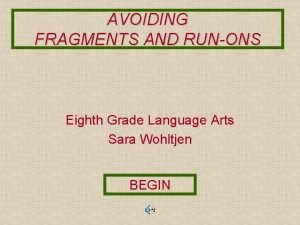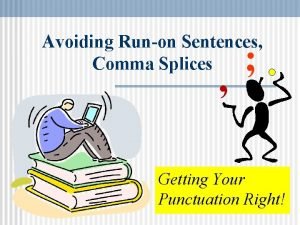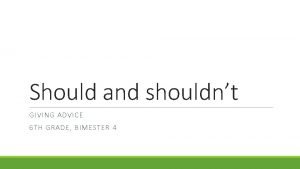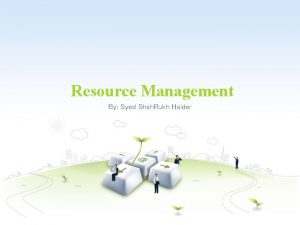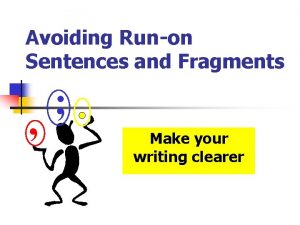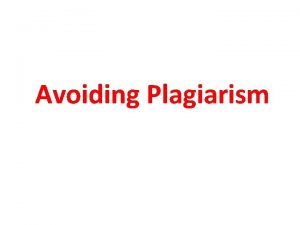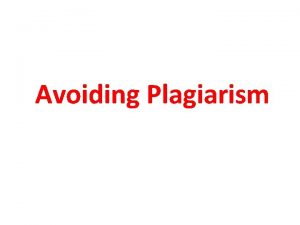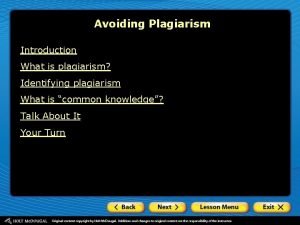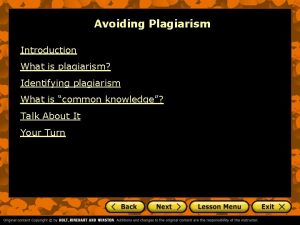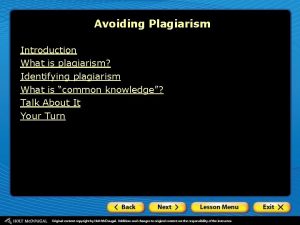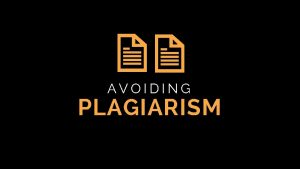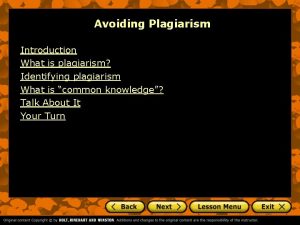Avoiding Plagiarism What is Plagiarism Using others ideas










- Slides: 10

Avoiding Plagiarism

What is Plagiarism? • “Using others’ ideas and words without clearly acknowledging the source of that information” 1 • A form of fraud and intellectual theft 2 • Does not occur exclusively in writing; can also be found in media like art, music, math, science, and technology 3 • Can be intentional or unintentional Pirillo & Fitz 1. “Plagiarism: What It is and How to Recognize and Avoid It, ” Indiana University Writing Tutorial Services, last modified April 7, 2014, http: //www. indiana. edu/~wts/pamphlets/plagiarism. shtml 2. Ibid. 3. “How to Avoid Plagiarism, ” Northwestern, accessed March 22, 2016, http: //www. northwestern. edu/provost/policies/academic-integrity/how-to-avoidplagiarism. html

4. K Covintree, What is plagiarism? , slideshow, April 26, 2011, http: //www. slideshare. net/covs/what-is-plagiarism-7743417

Consequences Regardless of whether it is intentional, plagiarism often comes with significant academic punishment, which can include: • Assignment failure • Course failure • Suspension • Expulsion • Other forms of probation as seen fit by academic honor councils 123 rf. com In the working world, plagiarism can be grounds for loss of employment or, at the very least, loss of reputation in a company. 5 5. Avoiding Plagiarism, MIT Writing and Communication Center, accessed April 2, 2016, http: //cmsw. mit. edu/writing-and-communicationcenter/avoiding-plagiarism/

Avoiding Plagiarism: General Tips • • Always give credit when you use: • Another’s idea, theory, or opinion • Information (facts, statistics, graphs, drawings) that is not common knowledge • Quotations or paraphrases or summaries of another’s words 6 Proper sourcing is key– always make sure to include, as appropriate: • A page listing all sources consulted (i. e. “Works Cited” / “References” / “Bibliography”) • In-text citations when quoting or paraphrasing * When in doubt, cite it! 6. “Plagiarism: What It is and How to Recognize and Avoid It, ” Indiana University Writing Tutorial Services, last modified April 7, 2014, http: //www. indiana. edu/~wts/pamphlets/plagiarism. shtml

References Page • Unless otherwise specified by an instructor, make sure to have a page listing all sources used • Most commonly referred to as “Works Cited” (MLA format), or “References” (APA format), or “Bibliography” (Chicago style) Purdue OWL

In-text Citations • Always include in-text citations when quoting or paraphrasing content in the body of your work (according to appropriate formatting guidelines) • Even when paraphrasing (taking another person’s ideas and putting them in your own words) rather than directly quoting, it is necessary to cite–summarizing in your own words does not change the fact that it is another person’s idea! Make sure to truly use your own words– simply changing a word or two around is still plagiarizing, not paraphrasing!7 7. “Plagiarism, ” The Writing Center at UNC-Chapel Hill, accessed March 22, 2016, http: //writingcenter. unc. edu/handouts/plagiarism/

What about… my own work? • Copying or referencing your own work used previously for another assignment or class still requires a citation • Using your own past material without citing yourself is called self-plagiarism and is not allowed (unless given explicit instructor permission) • Treat your previous work just as you would a work by another author 8 123 rf. com 8. “ 6 Ways to Avoid Plagiarism in Research Papers, ” Write. Check, accessed April 2, 2016, http: //en. writecheck. com/ways-to-avoid-plagiarism/

What about… common knowledge? • Generally, you do not need to cite common knowledge • General common knowledge: factual information in the public domain; can be found in many standard reference works birth and death dates of well-known figures • dates of military, political, literary, and other historical events • • Field-specific common knowledge: facts, theories, or methods familiar to readers within the discipline • • must be widely known enough within the field to be shared by readers 9 Since you are likely just learning this information, it is not “common knowledge” to you yet— if you did not know the info before taking the course, cite it!10 If unsure about whether something is common knowledge, be cautious and cite it! 9. “How to avoid plagiarism, ” The Writing Center at The University of Wisconsin-Madison, last modified August 29, 2014, https: //writing. wisc. edu/Handbook/QPA_plagiarism. html 10. “Plagiarism, ” The Writing Center at UNC-Chapel Hill, accessed March 22, 2016, http: //writingcenter. unc. edu/handouts/plagiarism/

Avoiding plagiarism is easy with just a little awareness and effort– doing so will only benefit yourself and others! 123 rf. com
 Apa 7 uts
Apa 7 uts Demographic parity
Demographic parity Alfred adler birth order
Alfred adler birth order Avoiding fragments and run-ons
Avoiding fragments and run-ons Avoiding run on sentences
Avoiding run on sentences Competing shark
Competing shark Complete the introduction giving advice on avoiding
Complete the introduction giving advice on avoiding What's the best strategy for avoiding atm fees?
What's the best strategy for avoiding atm fees? Introduction of position in nursing
Introduction of position in nursing Hr department structure
Hr department structure Avoiding run on sentences
Avoiding run on sentences



